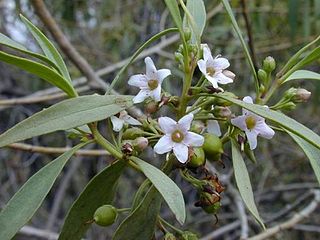
Myoporum is a genus of flowering plants in the figwort family, Scrophulariaceae. There are 30 species in the genus, eighteen of which are endemic to Australia although others are endemic to Pacific Islands, including New Zealand, and one is endemic to two Indian Ocean islands. They are shrubs or small trees with leaves that are arranged alternately and have white, occasionally pink flowers and a fruit that is a drupe.
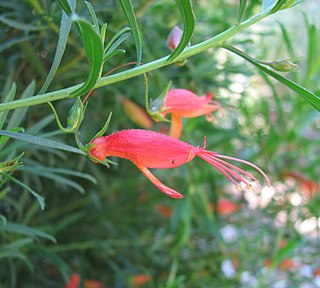
Eremophila decipiens, commonly known as slender fuchsia bush or narrow-leaved fuchsia bush is a flowering plant in the figwort family, Scrophulariaceae and is endemic to an area extending from the south-west of Western Australia to southern parts of South Australia. It is low, sprawling shrub with lance-shaped leaves and red, orange or yellow flowers on a long, S-shaped stalk.

Myoporum insulare, commonly known as common boobialla, native juniper, is a species of flowering plant in the figwort family Scrophulariaceae and is endemic to coastal areas of Australia. It is a shrub or small tree which grows on dunes and coastal cliffs, is very salt tolerant and widely used in horticulture.

Myoporum parvifolium, commonly known as creeping boobialla, creeping myoporum, dwarf native myrtle or small leaved myoporum is a plant in the figwort family, Scrophulariaceae. It is a low, spreading shrub with long, trailing stems and white, star-shaped flowers and is endemic to southern Australia including Flinders Island.

Myoporum viscosum, commonly known as sticky boobialla, is a plant in the figwort family, Scrophulariaceae and is endemic to South Australia. It is unusual in that sometimes, especially when the leaves are crushed, it has an extremely unpleasant smell.

Myoporum petiolatum, commonly known as sticky boobialla, is a plant in the figwort family Scrophulariaceae, and is endemic to the south-east of continental Australia. For many years this species has been confused with the much less common species Myoporum viscosum from which it can be distinguished by its thinner, noticeably petiolate and non-odorous leaves.
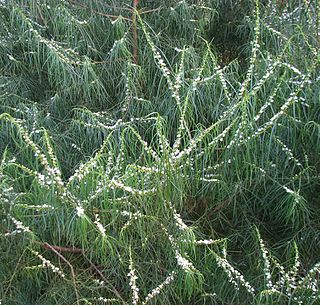
Myoporum floribundum, commonly known as weeping myoporum or slender myoporum, is a sour-smelling glabrous shrub in the family Scrophulariaceae endemic to a small area of New South Wales and Victoria in Australia. It has long, thin, drooping leaves and profuse white flowers in clusters along the stems in spring. Although it is uncommon in nature, it has long been available as a popular garden plant.
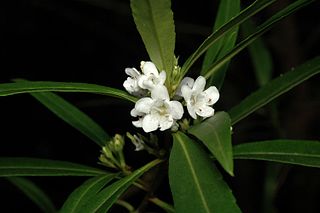
Myoporum betcheanum, commonly known as mountain boobialla is a plant in the figwort family, Scrophulariaceae. It is a shrub or small tree with long, narrow leaves that are a darker green on their upper surface than the lower. Its flowers have five white petals and are arranged in small groups in the leaf axils. The fruits which follow are more or less spherical, soft, cream coloured drupes. As its common name suggests, this plant is restricted to higher places, around 1,000 metres (3,000 ft) above sea level. It occurs in the McPherson Range and nearby mountains of New South Wales and Queensland.
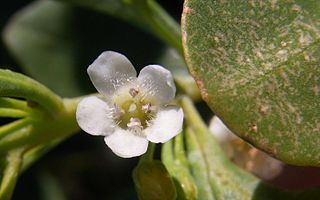
Myoporum boninense is a plant in the figwort family, Scrophulariaceae. It is a shrub with thick, fleshy, glossy leaves, white flowers in small groups and shiny lilac to pale purple fruits. It grows in coastal heath in New South Wales and Queensland in Australia and on islands in the north west Pacific Ocean.
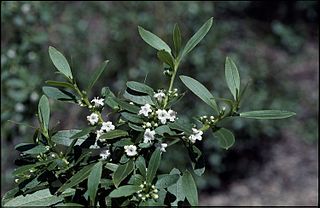
Myoporum caprarioides, commonly known as slender myoporum, is a plant in the figwort family, Scrophulariaceae. It is a shrub with wart-like tubercles covering its branches and leaves, especially on the upper surface and white flowers spotted with mauve, or all blue-mauve, present for most of the warmer months.

Myoporum cordifolium, commonly known as Jerramungup myoporum, is a plant in the figwort family, Scrophulariaceae. It is a shrub with thin, stiff branches and tiny, heart-shaped leaves, both covered with wart-like tubercles. Single white flowers with purple spots develop in the leaf axils and are followed by wrinkled green or brown fruits. It is endemic to a small area in the south-west of Western Australia
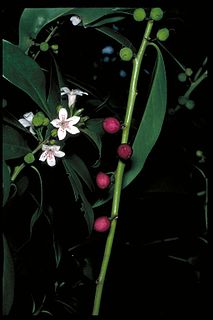
Myoporum obscurum, commonly known as popwood, sandalwood or bastard ironwood is a plant in the figwort family, Scrophulariaceae. It is a very rare shrub, endemic to Norfolk Island where it occurs in a few scattered locations.

Myoporum oppositifolium, commonly known as twin-leaf myoporum, is a plant in the figwort family, Scrophulariaceae. It is easily distinguished from others in the genus by the combination of glabrous leaves and branches, its opposite leaf arrangement and its serrated leaves. Its distribution is restricted to the extreme south-west of Western Australia.

Myoporum turbinatum, commonly known as salt myoporum, is a plant in the figwort family, Scrophulariaceae and is endemic to a small area near Esperance in Western Australia. It is closely related to Myoporum platycarpum but has much narrower leaves and differently shaped fruit. Its sticky branches and narrow, warty leaves are distinctive.
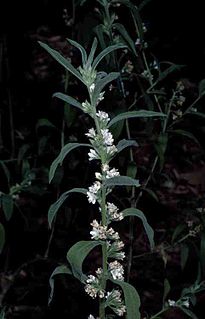
Myoporum velutinum is a plant in the figwort family, Scrophulariaceae and is endemic to a small area near Esperance in Western Australia. It has similar flowers and fruits and grows in similar environments to Myoporum tetrandrum but differs from it and all other members of the genus by having hairs on the outer edge of the petals.
Glycocystis beckeri is the only species of the flowering plant genus Glycocystis in the family Scrophulariaceae and is endemic to the south west of Western Australia. It is a shrub, similar to others in the genera Eremophila and Myoporum but is unusual in that it produces very large amounts of sticky, sweet-smelling resin produced by raised glands which cover the entire plant, except for the petals. It has been suggested that the resin traps insects which the plant uses as a source of nitrogen.

Eremophila chamaephila, commonly known as earth-loving poverty bush is a flowering plant in the figwort family, Scrophulariaceae and is endemic to the south-west of Western Australia. It is a low, dense, spreading shrub with small, fleshy leaves and mauve to purple flowers.

Eremophila glandulifera is a flowering plant in the figwort family, Scrophulariaceae and is endemic to Western Australia. It is a small shrub with hairy, grey foliage and attractive deep pink to red flowers usually growing in mulga woodland.

Eremophila psilocalyx is a flowering plant in the figwort family, Scrophulariaceae and is endemic to Western Australia. It is an erect shrub with a broom-like shape, narrow, hooked leaves and white, pink, blue or purple flowers. It is common in the mallee country around Esperance. It was sometimes incorrectly known as Eremophila pachyphylla.
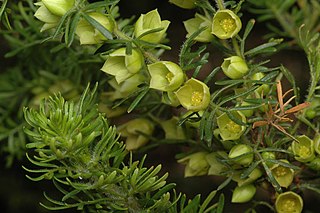
Boronia tetrandra, commonly known as yellow boronia, is a plant in the citrus family, Rutaceae and is endemic to Western Australia. It is a spreading or erect shrub with hairy stems, pinnate leaves and greenish cream to yellow or reddish brown, cup-shaped, four-petalled flowers.



















